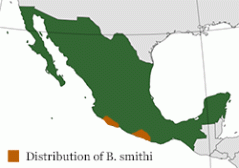Tarantula Tuesday: The Mexican Red-Knee
For the first highlighted species, I’m going to talk about a hobby classic, the Mexican red-knee (Brachypelma smithi).
The Mexican red-knee is an iconic tarantula, recognized by many and considered to be the stereotypical tarantula. It has even been used in old movies, such as Tarantula. This beautiful species is highly sought after due to its docile nature, bright colors, and hardiness. Care is simple because the red-knee doesn’t need a high humidity and can tolerate long periods with little/no food or water. The hardiness comes from being a desert dwelling terrestrial tarantula. Red-knees are found on the west coast of Mexico.
While only found in a couple small areas of Mexico, this species has been captive bred for years, much to the delight of arachnophiliacs such as myself. B. smithi‘s being captive bred drops the price and causes less environmental stress because fewer individuals are being wild-caught and shipped throughout the world. And as an added bonus, people can now have a tiny red-knee spiderling that they can watch grow, sometimes even starting from 1/4 inch (0.6 cm)! They can live for a long time, with B. smithi females living for over 20 years quite easily. Males are not as long lived, dying a few months after they molt into maturity, which usually only takes around five years.
In terms of care, B. smithi‘s are extremely simple to keep. As a terrestrial tarantula, floor space is much more important than height. In fact, less height is a good thing because there is a smaller chance that the tarantula will fall and injure itself. Fall are dangerous for a tarantula. Even a fall of a few inches could be deadly (assuming it’s a terrestrial species. Arboreal species can take falls better).
All that this tarantula needs is a couple inches of substrate to burrow into and rearrange as it pleases, a hide of some sort (could be a piece of corkbark, a flower pot, tupperware container, etc.), and a shallow water dish. That’s it. Humidity doesn’t need to be high, with around 50% being acceptable. I personally mist mine once every week or two and make sure that the water dish stays full.
This beautiful tarantula is a treat to keep, and I recommend them to anyone and everyone who loves tarantulas.
References:
“Brachypelma Smithi.” Brachypelma Smithi. Web. 19 Nov. 2013. <http://www.mantid.nl/tarantula/smithi.html>.
Deakin, Billy. “Brachypelma Smithi – Mexican Redknee Tarantula Caresheet.” Tarantula Care. N.p., 2012. Web. 19 Nov. 2013. <http://tarantula-care.com/brachypelma-smithi-mexican-redknee-tarantula/>.
Schultz, Stanley A., and Marguerite J. Schultz. The Tarantula Keeper’s Guide. Hauppauge, NY: Barron’s Educational Series, 1998. Print.


